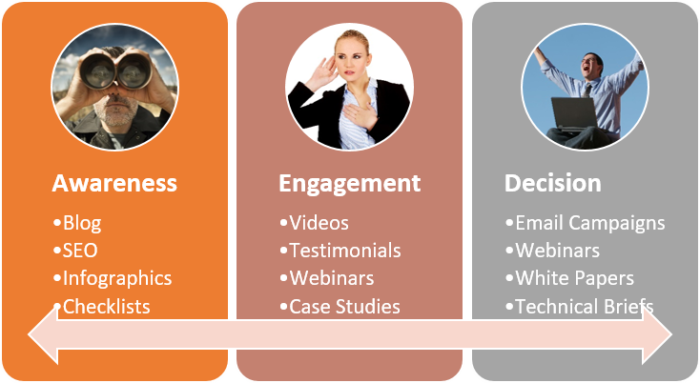“Oh sure,” you say. “Just what I need, another line item in my budget. Gabe or Laura will write it.”
But Gabe is madly creating pages for a major website overhaul, and Laura is heads-down on media relations for a big launch. They must do what they’re doing; the blog / white paper / eBook / case study will wait.
And wait.
And wait.
Meanwhile your content marketing isn’t showing the results you hoped for, the CMO is not impressed, and Sales is being, well… Sales.
The upshot is you saved $5,000 by not using a freelancer. And you lost $150,000 from the qualified leads who would have engaged with your company thanks to your engaging content.
They went to your competitor instead. The one with the active content.
“Don’t think mediocre content cuts it. We’re in the middle of a content arms race. As more B2B marketers adopt best practices, buyer expectations continue to rise. They demand greater insights and information tailored to their deepest needs, not generic one-size-fits-all platitudes. That means you need to bring your A game.” (Chuck Frey)
Freelancers Can Fix It
Good freelancers understand your difficult role as a B2B marketer. You strive to help your clients hit their marketing objectives and sales goals. You position and focus and create the content that reels in the leads. You don’t stop until you fill that sales funnel — in fact, you don’t stop at all.
That’s where we come in. We lighten your load by taking on your strategies, messaging, facts, logic, and stories. We build them into persuasive content, and analyze the analysis so we can adjust and improve. Then we do it all over again, as long as you need us.
Unsurprisingly, Good Content Marketing Takes a Lot of Good Content
“Times They Are a-Changin’”, wrote Bob Dylan, although he may or may not have shown up in Stockholm.
Nobel prizes aside, this is true for B2B technology sales cycles. In the good old days, prospective customers called up IBM or Sun to see what’s new and if they needed it. After a few years, buyers heard of some scrappers called Network Appliance and Hewlett Packard, and called them to start the sales process.
Three out of four of those companies are still around, but this isn’t the way it works anymore. Today people fire up Google to launch the buying process.
75-80% of prospects conduct their own research online before they ever reach out to vendors. They’ll search and read, talk to their peers. They may or may not run across your product in their research. And if they do, they may – or may not – care.
You need them to care. They need to understand what you do and why you do it and how you are going to make their work lives better. How do you get the message across if they won’t talk to you until you’re on the short list, or may never talk to you at all?
This is where content marketing comes in. The Content Marketing Institute defines content marketing like this: “A strategic marketing approach focused on creating and distributing valuable, relevant, and consistent content to attract and retain a clearly-defined audience — and, ultimately, to drive profitable customer action.”
Takeaway: Stack the odds in your favor. Create and position content for three main sales stages: brand awareness, customer research, and buying decision.
When they’re searching for the type of solution you offer, and you have put out plenty of good content, they’ll find you.
Put your interesting, attention-grabbing, original thought pieces out there. Readers will like it and look for more. They’ll read your blog, maybe subscribe. They like the eBook download with checklists, which has practical tips for their real problems. And they really like the persuasive white paper that they can share with their boss, because by now you’re on their short-short list.
Takeaway: You need quality, interesting content written for strategic marketing and lead capture. Invest in a B2B copywriter who knows what to write, how to write, and who to write it for.
You know that you’ve got to get the content in front of your prospects. Link to it on social media, support it with email, send it to sales and channel partners, post it on the website, create landing pages, capture sign-ups – yeah, it’s a lot. But it’s worth it because unshared content is as useful as a helium-filled paperweight.
Not everyone sets up analytics on content. It takes web page analytics, social media analytics, and download tracking. None of it is particularly hard to do, but someone must set it up and keep it going.
Marketing acts on analytics by consistently monitoring and adjusting.
- How many sign-ups did the new eBook get this week? How many downloads from your website, how many click-throughs from the landing page?
- The thought leadership piece is three times as popular as the technical white paper, or is the other way around?
- And look at that – people shared your infographic 972 times and counting.
Track the content your prospects are consuming. Plan content additions, revisions, and marketing channels accordingly.
Takeaway: Invest in a B2B copywriter who understands your analytics and uses the information to adjust content.
Call me a snoop, but when I’m at a technology conference I glance around at what other people are doing on their laptops. While the speaker drones on, people are typing emails, checking their Twitter feed, and reading the news. I’m pretty sure I saw one top analyst sneak onto a recipe site.
The same fate befalls boring content. When your white paper comes over the transom, your would-be readers don’t even have to feign interest. They’ll scan your headline and make a run to a recipe site.
The fix? Good design is important, but stories are vital. Story-led content increases brand awareness and encourages downloads and shares. In B2B marketing, the customer success story is the most obvious example. Another example are white papers that illustrate challenges and solutions using stories. Infographics, email, video, presentations: stories work because people remember.
Takeaway: Find an experienced copywriter who knows how to punch up your content and tell your stories.
Marketing pros give it all to their clients. Let B2B content writers give their all to you.





